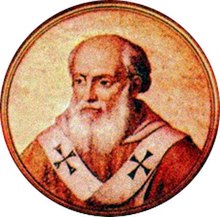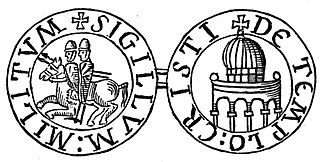
The Poor Fellow-Soldiers of Christ and of the Temple of Solomon, also known as the Order of Solomon's Temple, the Knights Templar, or simply the Templars, was a military order of the Catholic faith, and one of the wealthiest and most popular military orders in Western Christianity. They were founded circa 1119, headquartered on the Temple Mount in Jerusalem, and existed for nearly two centuries during the Middle Ages.
The Northern Crusades or Baltic Crusades were Christian colonization and Christianization campaigns undertaken by Catholic Christian military orders and kingdoms, primarily against the pagan Baltic, Finnic and West Slavic peoples around the southern and eastern shores of the Baltic Sea, and also against Orthodox Christian Slavs.
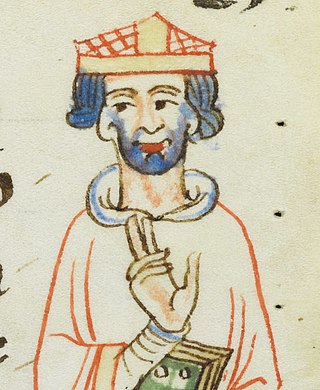
Pope Honorius III, born Cencio Savelli, was head of the Catholic Church and ruler of the Papal States from 18 July 1216 to his death. A canon at the Basilica di Santa Maria Maggiore, he came to hold a number of important administrative positions, including that of Camerlengo. In 1197, he became tutor to the young Frederick II. As pope, he worked to promote the Fifth Crusade, which had been planned under his predecessor, Innocent III. Honorius repeatedly exhorted King Andrew II of Hungary and Emperor Frederick II to fulfill their vows to participate. He also gave approval to the recently formed Dominican and Franciscan religious orders.

Pope Gregory X, born Teobaldo Visconti, was head of the Catholic Church and ruler of the Papal States from 1 September 1271 to his death and was a member of the Secular Franciscan Order. He was elected at the conclusion of a papal election that ran from 1268 to 1271, the longest papal election in the history of the Catholic Church.

Pope Gregory IX was head of the Catholic Church and ruler of the Papal States from 19 March 1227 until his death in 1241. He is known for issuing the Decretales and instituting the Papal Inquisition, in response to the failures of the episcopal inquisitions established during the time of Pope Lucius III, by means of the papal bull Ad abolendam, issued in 1184.

Pope Innocent III, born Lotario dei Conti di Segni, was the head of the Catholic Church and ruler of the Papal States from 8 January 1198 until his death on 16 July 1216.
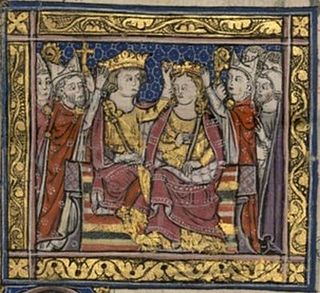
John of Brienne, also known as John I, was King of Jerusalem from 1210 to 1225 and Latin Emperor of Constantinople from 1229 to 1237. He was the youngest son of Erard II of Brienne, a wealthy nobleman in Champagne. John, originally destined for an ecclesiastical career, became a knight and owned small estates in Champagne around 1200. After the death of his brother, Walter III, he ruled the County of Brienne on behalf of his minor nephew Walter IV.
Omne datum optimum was a papal bull issued by Pope Innocent II on 29 March 1139 that endorsed the Order of the Poor Knights of Christ and of the Temple of Solomon, in which the Templar Rule was officially approved, and papal protection given.
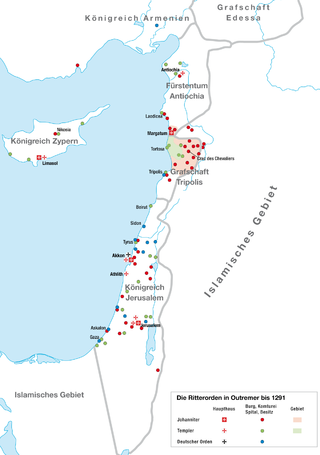
A military order is a Christian religious society of knights. The original military orders were the Knights Templar, the Knights Hospitaller, the Order of Saint James, the Order of Calatrava, and the Teutonic Knights. They arose in the Middle Ages in association with the Crusades, both in the Holy Land, the Baltics, and the Iberian peninsula; their members being dedicated to the protection of pilgrims and Christians, as well as the defence of the Crusader states. They are the predecessors of chivalric orders.
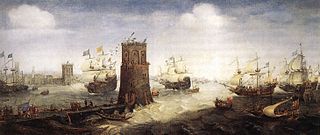
The Fifth Crusade (1217–1221) was a campaign in a series of Crusades by Western Europeans to reacquire Jerusalem and the rest of the Holy Land by first conquering Egypt, ruled by the powerful Ayyubid sultanate, led by al-Adil, brother of Saladin.
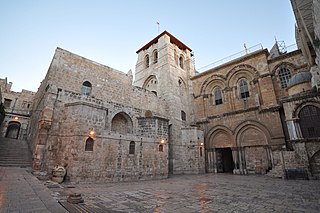
The crusading movement was a framework of ideologies and institutions that described, regulated, and promoted the Crusades. Members of the Church defined the movement in legal and theological terms based on the concepts of holy war and pilgrimage. Theologically, the movement merged ideas of Old Testament wars that were instigated and assisted by God with New Testament ideas of forming personal relationships with Christ. The concept of crusading as holy war was based on the ancient idea of just war, in which an authority initiates the war, there is just cause, and the war is waged with pureness of intention. Adherents saw Crusades as special pilgrimages – a physical and spiritual journey under the authority and protection of the Church. Pilgrimage and crusade were penitent acts and they considered participants part of Christ's army. While this was only metaphorical before the First Crusade, the concept transferred from the clergy to the wider world. Crusaders attached crosses of cloth to their outfits, marking them as followers and devotees of Christ, responding to the biblical passage in Luke 9:23 which instructed them to carry one's cross and follow Christ. Anyone could be involved and the church considered those who died campaigning martyrs. After the First Crusade the movement became an important part of late-medieval western culture, impacting politics, the economy and society.
The Second Council of Lyon was the fourteenth ecumenical council of the Roman Catholic Church, convoked on 31 March 1272 and convened in Lyon, Kingdom of Arles, in 1274. Pope Gregory X presided over the council, called to act on a pledge by Byzantine emperor Michael VIII to reunite the Eastern church with the West. The council was attended by about 300 bishops, 60 abbots and more than a thousand prelates or their procurators, among whom were the representatives of the universities. Due to the great number of attendees, those who had come to Lyon without being specifically summoned were given "leave to depart with the blessing of God" and of the Pope. Among others who attended the council were James I of Aragon, the ambassador of the Emperor Michael VIII Palaiologos with members of the Greek clergy and the ambassadors of Abaqa Khan of the Ilkhanate. Thomas Aquinas had been summoned to the council, but died en route at Fossanova Abbey. Bonaventure was present at the first four sessions but died at Lyon on 15 July 1274. As at the First Council of Lyon, Thomas Cantilupe was an English attendee and a papal chaplain.

The Equestrian Order of the Holy Sepulchre of Jerusalem, also called Order of the Holy Sepulchre or Knights of the Holy Sepulchre, is a Catholic order of knighthood under the protection of the Holy See. The pope is the sovereign of the order. The order creates "canons" as well as knights, with the primary mission to "support the Christian presence in the Holy Land". It is an internationally recognized order of chivalry.

The Order of Saint Lazarus of Jerusalem, also known as the Leper Brothers of Jerusalem or simply as Lazarists, was a Catholic military order founded by Crusaders around 1119 at a leper hospital in Jerusalem, Kingdom of Jerusalem, whose care became its original purpose, named after its patron saint, Lazarus. It was recognised by King Fulk of Jerusalem in 1142 and canonically recognised as a hospitaller and military order of chivalry under the rule of Saint Augustine in the Papal bull Cum a Nobis Petitur of Pope Alexander IV in 1255. Although they were centred on their charism of caring for those afflicted with leprosy, the knights of the Order of Saint Lazarus notably fought in the Battle of La Forbie in 1244 and in the Defense of Acre in 1291. The titular seat was successively situated at Jerusalem, then Acre. After the fall of the Kingdom of Jerusalem, the order split into two main branches – in Italy and in France.

The Crusades were a series of religious wars initiated, supported, and sometimes directed by the Christian Latin Church in the medieval period. The best known of these military expeditions are those to the Holy Land in the period between 1095 and 1291 that were intended to conquer Jerusalem and its surrounding area from Muslim rule. Beginning with the First Crusade, which resulted in the conquest of Jerusalem in 1099, dozens of military campaigns were organised, providing a focal point of European history for centuries. Crusading declined rapidly after the 15th century.

The Eastern Roman (Byzantine) imperial church headed by Constantinople continued to assert its universal authority. By the 13th century this assertion was becoming increasingly irrelevant as the Eastern Roman Empire shrank and the Ottoman Turks took over most of what was left of the Byzantine Empire. The other Eastern European churches in communion with Constantinople were not part of its empire and were increasingly acting independently, achieving autocephalous status and only nominally acknowledging Constantinople's standing in the Church hierarchy. In Western Europe the Holy Roman Empire fragmented making it less of an empire as well.

Papal income tax was first levied in 1199 by Pope Innocent III, originally requiring all Catholic clergy to pay one-fortieth of their ecclesiastical income annually in support of the Crusades. The second income tax was not levied until the Fourth Lateran Council in 1215, and constituted only a triennial twentieth.
The orders, decorations, and medals of the Holy See include titles, chivalric orders, distinctions and medals honoured by the Holy See, with the Pope as the fount of honour, for deeds and merits of their recipients to the benefit of the Holy See, the Catholic Church, or their respective communities, societies, nations and the world at large.

The Barons' Crusade (1239–1241), also called the Crusade of 1239, was a crusade to the Holy Land that, in territorial terms, was the most successful crusade since the First Crusade. Called by Pope Gregory IX, the Barons' Crusade broadly embodied the highest point of papal endeavor "to make crusading a universal Christian undertaking." Gregory IX called for a crusade in France, England, and Hungary with different degrees of success. Although the crusaders did not achieve any glorious military victories, they used diplomacy to successfully play the two warring factions of the Ayyubid dynasty against one another for even more concessions than Frederick II had gained during the more well-known Sixth Crusade. For a few years, the Barons' Crusade returned the Kingdom of Jerusalem to its largest size since 1187.

The siege of Alcácer do Sal lasted from 30 July to 18 October 1217. The well fortified city of Alcácer do Sal was a frontier outpost of the Almohad Caliphate facing Portugal. It was besieged by forces from Portugal, León, the military orders and the Fifth Crusade. The latter were led by Count William I of Holland. The expedition was the brainchild of Bishop Soeiro II of Lisbon, whose diocese was threatened by regular raids from Alcácer. King Afonso II of Portugal did not take part in person, but the city was incorporated into his kingdom after its capitulation. The crusaders who took part in the siege, mainly from the Rhineland and the Low Countries, did so without papal authorization and were afterwards ordered to continue on to the Holy Land.
